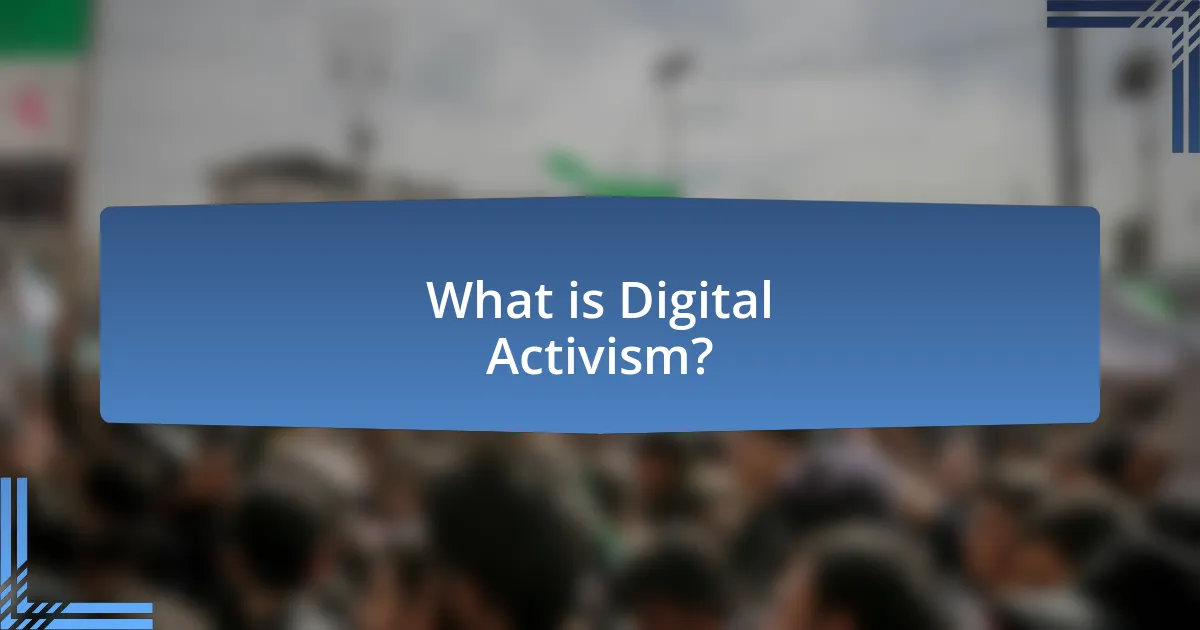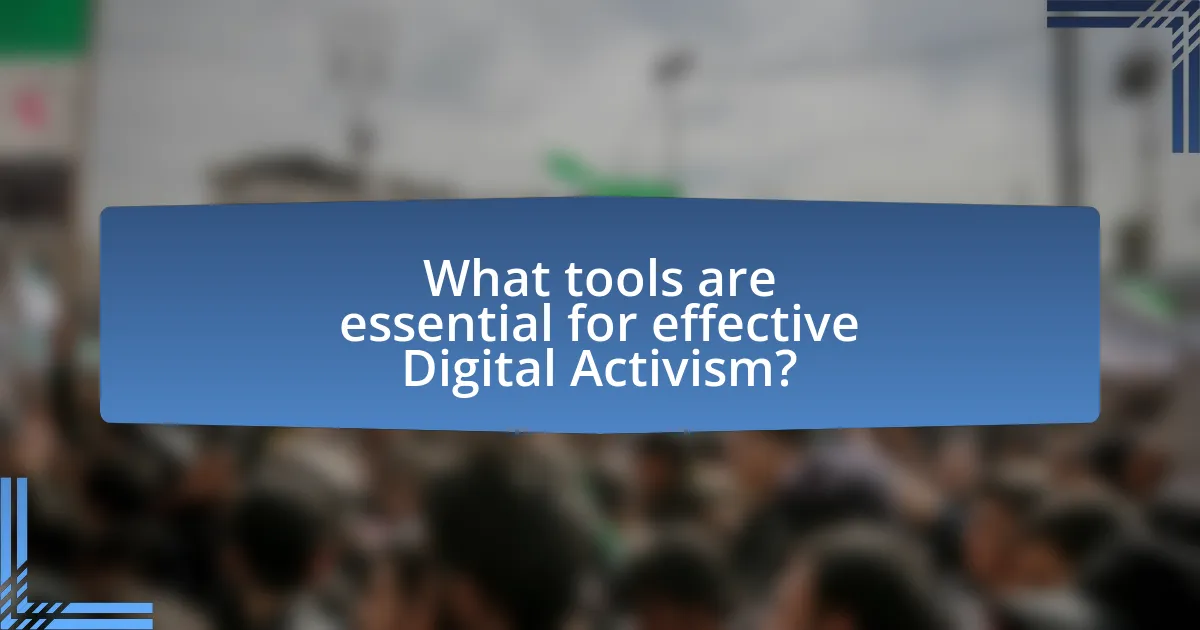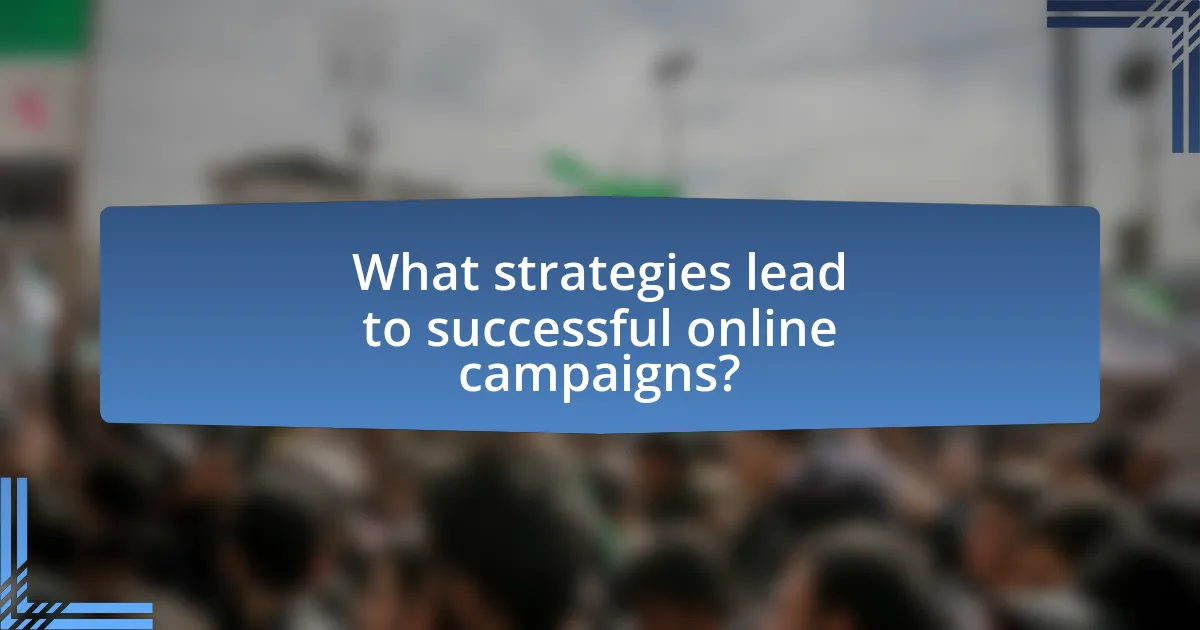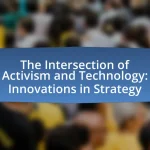Digital activism refers to the use of digital tools and platforms to advocate for social, political, or environmental change, leveraging social media and online campaigns to mobilize support and influence public opinion. The article explores the evolution of digital activism from its inception in the 1990s to its current state, highlighting significant historical events like the Arab Spring and the #MeToo movement that have shaped its development. It discusses the impact of technological advancements on activism, the importance of effective tools and strategies for online campaigns, and the role of social media in facilitating engagement and community building. Additionally, the article addresses challenges faced in digital activism, such as misinformation and online harassment, while providing practical tips for enhancing activism efforts.

What is Digital Activism?
Digital activism is the use of digital tools and platforms to promote social, political, or environmental change. This form of activism leverages social media, websites, and online campaigns to mobilize support, raise awareness, and influence public opinion. For instance, movements like #BlackLivesMatter and #MeToo have effectively utilized digital activism to reach global audiences and drive significant societal discussions. The rise of internet access and mobile technology has further amplified the impact of digital activism, enabling rapid dissemination of information and fostering community engagement across diverse demographics.
How has Digital Activism evolved over time?
Digital activism has evolved significantly from its early days in the 1990s, transitioning from simple email campaigns and online petitions to complex, multi-platform movements utilizing social media, mobile apps, and data analytics. Initially, digital activism focused on raising awareness through websites and email lists, exemplified by campaigns like the 1999 anti-WTO protests, which used the internet to mobilize participants. Over time, the rise of social media platforms such as Facebook and Twitter in the 2000s enabled real-time communication and broader outreach, as seen in movements like the Arab Spring in 2010-2011, where social media played a crucial role in organizing protests and disseminating information. More recently, digital activism has incorporated advanced technologies like artificial intelligence and big data to analyze trends and target specific demographics, enhancing the effectiveness of campaigns such as Black Lives Matter and climate change initiatives. This evolution reflects a growing understanding of the internet’s potential to facilitate grassroots movements and influence public policy on a global scale.
What historical events have shaped Digital Activism?
The historical events that have shaped digital activism include the Arab Spring in 2010-2011, which demonstrated the power of social media in mobilizing protests and disseminating information rapidly. The use of platforms like Twitter and Facebook allowed activists to organize and communicate, leading to significant political changes in several countries. Another pivotal event was the Occupy Wall Street movement in 2011, which utilized digital tools to raise awareness about economic inequality and corporate influence in politics, showcasing the effectiveness of online campaigns in garnering global support. Additionally, the #MeToo movement, which gained momentum in 2017, highlighted the role of social media in amplifying voices against sexual harassment and assault, further solidifying digital activism as a crucial tool for social change. These events collectively illustrate how digital platforms have transformed activism by enabling widespread participation and facilitating real-time communication.
How do technological advancements influence Digital Activism?
Technological advancements significantly enhance digital activism by providing new tools and platforms that facilitate communication, organization, and mobilization. For instance, social media platforms like Twitter and Facebook enable activists to reach a global audience instantly, allowing for rapid dissemination of information and coordination of campaigns. According to a study by the Pew Research Center, 69% of adults in the U.S. use social media, which underscores the potential reach for digital activism efforts. Additionally, advancements in mobile technology allow activists to organize protests and share real-time updates, as seen during the Arab Spring, where mobile phones played a crucial role in coordinating demonstrations. These technologies not only amplify voices but also create networks of support, making digital activism more effective and impactful.
Why is Digital Activism important in today’s society?
Digital activism is important in today’s society because it enables rapid mobilization and engagement on social issues through online platforms. This form of activism allows individuals and organizations to reach a global audience instantly, facilitating awareness and advocacy for causes such as climate change, human rights, and social justice. For instance, the #MeToo movement gained significant traction through social media, highlighting the prevalence of sexual harassment and assault, which led to widespread societal discussions and policy changes. Additionally, studies show that digital campaigns can increase participation in protests and civic activities, demonstrating their effectiveness in driving real-world change.
What role does Digital Activism play in social change?
Digital activism plays a crucial role in social change by leveraging online platforms to mobilize individuals, raise awareness, and influence public policy. It enables grassroots movements to gain visibility and support, often leading to significant societal shifts. For instance, the #BlackLivesMatter movement utilized social media to highlight racial injustices, resulting in widespread protests and policy discussions on police reform. Additionally, studies show that digital campaigns can increase engagement and participation in social issues, as evidenced by the 2017 Women’s March, which drew millions globally through online organizing. This demonstrates that digital activism not only amplifies voices but also catalyzes tangible changes in societal norms and legislation.
How does Digital Activism empower marginalized communities?
Digital activism empowers marginalized communities by providing them with accessible platforms to voice their concerns and mobilize support. These digital tools enable individuals from underrepresented groups to share their stories, organize campaigns, and connect with allies globally, thereby amplifying their messages. For instance, social media platforms like Twitter and Facebook have been instrumental in movements such as #BlackLivesMatter, which has raised awareness about racial injustice and mobilized protests across the world. Research indicates that online activism can lead to significant offline actions, as seen in the Arab Spring, where digital communication facilitated mass mobilization against oppressive regimes. This demonstrates that digital activism not only enhances visibility for marginalized voices but also fosters community solidarity and action.

What tools are essential for effective Digital Activism?
Essential tools for effective digital activism include social media platforms, email marketing services, content creation tools, and analytics software. Social media platforms like Twitter and Facebook facilitate widespread communication and mobilization, allowing activists to reach large audiences quickly. Email marketing services, such as Mailchimp, enable targeted outreach and engagement with supporters. Content creation tools, like Canva and Adobe Spark, assist in designing impactful visuals and materials that enhance messaging. Analytics software, such as Google Analytics, provides insights into campaign performance, helping activists refine their strategies based on data-driven results. These tools collectively empower digital activists to organize, communicate, and measure the impact of their efforts effectively.
How do social media platforms facilitate Digital Activism?
Social media platforms facilitate digital activism by providing accessible tools for communication, organization, and mobilization. These platforms enable activists to reach a global audience quickly, allowing for the rapid dissemination of information and the ability to rally support for various causes. For instance, the hashtag movement, such as #BlackLivesMatter, has shown how social media can amplify voices and create awareness around social issues, leading to real-world protests and policy discussions. Additionally, studies indicate that social media campaigns can significantly increase engagement and participation in activism, with platforms like Twitter and Facebook being instrumental in organizing events and sharing resources.
What features of social media are most beneficial for activists?
The most beneficial features of social media for activists include real-time communication, broad reach, and the ability to mobilize supporters quickly. Real-time communication allows activists to share updates and organize events instantly, fostering immediate engagement. The broad reach of social media platforms enables activists to connect with diverse audiences, amplifying their messages beyond geographical boundaries. Additionally, features like hashtags and trending topics facilitate the mobilization of supporters, as seen in movements like #BlackLivesMatter, which gained global attention and support through strategic social media use. These features collectively enhance the effectiveness of digital activism by promoting awareness and encouraging participation.
How can activists leverage social media algorithms for visibility?
Activists can leverage social media algorithms for visibility by creating engaging, shareable content that aligns with trending topics and user interests. By utilizing hashtags, participating in conversations, and posting during peak engagement times, activists can increase their content’s reach. Research indicates that posts with visuals receive 94% more views, highlighting the importance of incorporating images or videos to capture attention. Additionally, engaging with followers through comments and shares can boost algorithmic favorability, leading to greater visibility.
What other digital tools enhance online campaigns?
Digital tools that enhance online campaigns include social media management platforms, email marketing software, analytics tools, and content creation applications. Social media management platforms like Hootsuite and Buffer allow for scheduling and monitoring posts across multiple channels, increasing engagement and reach. Email marketing software such as Mailchimp enables targeted communication with audiences, improving conversion rates. Analytics tools like Google Analytics provide insights into user behavior and campaign performance, allowing for data-driven adjustments. Content creation applications, including Canva and Adobe Spark, facilitate the design of visually appealing graphics and videos, which are essential for capturing audience attention. These tools collectively improve the effectiveness and efficiency of online campaigns.
What role do websites and blogs play in Digital Activism?
Websites and blogs serve as critical platforms for digital activism by facilitating information dissemination, community engagement, and mobilization efforts. They provide activists with the ability to share their messages widely, reaching diverse audiences through accessible content. For instance, blogs can host detailed narratives and analyses that raise awareness about social issues, while websites can serve as hubs for resources, petitions, and event organization. According to a study by the Pew Research Center, 69% of adults in the U.S. use social media, which often links back to blogs and websites, amplifying the reach of activist campaigns. This interconnectedness enhances the visibility of social movements and fosters a sense of community among supporters.
How can email campaigns be effectively utilized in activism?
Email campaigns can be effectively utilized in activism by mobilizing supporters, raising awareness, and driving action through targeted messaging. Activist organizations can segment their audience based on interests and demographics, allowing for personalized content that resonates with recipients. For example, a study by the Pew Research Center found that 70% of email users prefer receiving updates from organizations they support, indicating that well-crafted emails can enhance engagement. Additionally, including clear calls to action, such as signing petitions or attending events, can significantly increase participation rates. Data from Mailchimp shows that emails with strong calls to action have a 371% higher click-through rate, demonstrating the effectiveness of strategic email campaigns in achieving activist goals.

What strategies lead to successful online campaigns?
Successful online campaigns utilize targeted audience engagement, compelling content creation, and data-driven strategies. Targeted audience engagement ensures that campaigns reach the right demographics, increasing the likelihood of interaction and conversion. Compelling content creation, including visuals and storytelling, captures attention and fosters emotional connections, which are crucial for driving action. Data-driven strategies involve analyzing metrics to refine approaches and optimize performance, as evidenced by a study from HubSpot indicating that companies using data analytics in their marketing efforts see a 20% increase in ROI. These strategies collectively enhance the effectiveness of online campaigns in achieving their goals.
How can activists create compelling content for their campaigns?
Activists can create compelling content for their campaigns by focusing on storytelling, utilizing visuals, and engaging their audience through interactive elements. Storytelling allows activists to connect emotionally with their audience, making the message more relatable and memorable. For instance, campaigns that share personal narratives or testimonials often see higher engagement rates, as evidenced by the success of the “It Gets Better” project, which used personal stories to address LGBTQ+ youth issues.
Utilizing visuals, such as infographics and videos, enhances the impact of the message, as research shows that visual content is processed 60,000 times faster than text. Engaging the audience through interactive elements, like polls or quizzes, fosters participation and investment in the cause, which can lead to increased support and sharing of the content. Overall, combining these strategies effectively captures attention and drives action in digital activism campaigns.
What types of content resonate most with online audiences?
Visual content, such as videos and infographics, resonates most with online audiences. Research indicates that posts with visuals receive 94% more views than those without, highlighting the effectiveness of engaging imagery in capturing attention. Additionally, storytelling content, which evokes emotions and personal connections, has been shown to increase audience engagement significantly, as narratives can enhance relatability and inspire action. According to a study by the Content Marketing Institute, 70% of consumers prefer to learn about a company through articles rather than ads, further emphasizing the importance of informative and relatable content in digital activism campaigns.
How can storytelling enhance the impact of Digital Activism?
Storytelling enhances the impact of digital activism by creating emotional connections that drive engagement and mobilization. When activists share personal narratives or compelling stories, they humanize issues, making them relatable and urgent for audiences. Research indicates that stories can increase empathy and understanding, leading to higher levels of support and action; for instance, a study published in the journal “Science” found that narratives can significantly influence people’s attitudes and behaviors. By framing social issues through storytelling, digital activists can effectively capture attention, foster community, and inspire collective action, ultimately amplifying their message and reach.
What are the best practices for engaging supporters online?
The best practices for engaging supporters online include creating compelling content, fostering community interaction, and utilizing data analytics to tailor communication. Compelling content, such as impactful stories and visuals, captures attention and encourages sharing, which is essential for expanding reach. Fostering community interaction through comments, polls, and live events builds a sense of belonging and encourages active participation. Utilizing data analytics allows organizations to understand supporter preferences and behaviors, enabling them to customize messages and improve engagement strategies. According to a study by the Pew Research Center, 69% of adults in the U.S. use social media, highlighting the importance of these platforms for reaching and engaging supporters effectively.
How can activists build and maintain an online community?
Activists can build and maintain an online community by utilizing social media platforms, engaging in consistent communication, and fostering a sense of belonging among members. Social media platforms like Facebook, Twitter, and Instagram allow activists to reach a wide audience and share their messages effectively. Consistent communication through regular updates, newsletters, and interactive content keeps community members informed and engaged. Additionally, creating opportunities for members to contribute, share their experiences, and participate in discussions enhances their sense of belonging, which is crucial for community retention. Research indicates that communities with high engagement levels are more likely to sustain their membership over time, demonstrating the importance of these strategies in maintaining an active online presence.
What methods can be used to measure the success of online campaigns?
To measure the success of online campaigns, key methods include tracking metrics such as conversion rates, engagement rates, and return on investment (ROI). Conversion rates indicate the percentage of users who complete a desired action, such as making a purchase or signing up for a newsletter, providing direct insight into campaign effectiveness. Engagement rates, which encompass likes, shares, comments, and click-through rates, reflect how well the content resonates with the audience. ROI quantifies the financial return generated from the campaign relative to its cost, allowing for a clear assessment of profitability. These metrics are supported by analytics tools like Google Analytics and social media insights, which provide concrete data for evaluating campaign performance.
What are common challenges faced in Digital Activism?
Common challenges faced in digital activism include online harassment, misinformation, and digital divide issues. Online harassment can deter activists from participating and sharing their messages, as evidenced by numerous reports highlighting threats and abuse directed at individuals involved in social movements. Misinformation complicates the dissemination of accurate information, leading to confusion and undermining campaigns; for instance, during the COVID-19 pandemic, false narratives spread rapidly, impacting public health responses. Additionally, the digital divide creates barriers for marginalized communities, limiting their access to technology and the internet, which hinders their ability to engage in digital activism effectively.
How can activists combat misinformation and online harassment?
Activists can combat misinformation and online harassment by employing fact-checking tools, promoting digital literacy, and creating supportive online communities. Fact-checking tools, such as Snopes and FactCheck.org, allow activists to verify claims and debunk false information quickly, which is essential in countering misinformation. Promoting digital literacy through workshops and online resources empowers individuals to critically evaluate information sources, reducing the spread of false narratives. Additionally, creating supportive online communities fosters a safe environment where individuals can report harassment and misinformation, encouraging collective action against these issues. Studies show that communities that actively engage in monitoring and reporting misinformation can significantly reduce its prevalence online.
What strategies can be employed to overcome digital fatigue among supporters?
To overcome digital fatigue among supporters, organizations can implement strategies such as diversifying content formats, setting clear communication boundaries, and encouraging offline engagement. Diversifying content formats, including videos, podcasts, and infographics, can capture attention more effectively than traditional text-based updates, as studies show that varied content increases user engagement by up to 80%. Setting clear communication boundaries, such as limiting the frequency of messages and providing opt-out options, helps prevent overwhelming supporters, which is crucial since research indicates that excessive communication can lead to disengagement. Encouraging offline engagement through events or community activities fosters personal connections and reduces reliance on digital platforms, addressing the fatigue caused by constant online interaction.
What practical tips can enhance Digital Activism efforts?
To enhance digital activism efforts, activists should focus on leveraging social media platforms effectively. Utilizing platforms like Twitter, Facebook, and Instagram allows for rapid dissemination of information and mobilization of supporters. Research indicates that campaigns that use targeted hashtags can increase visibility and engagement; for instance, the #BlackLivesMatter movement gained significant traction through strategic social media use. Additionally, creating compelling visual content, such as infographics and videos, can capture attention and convey messages more powerfully, as studies show that visual content is processed 60,000 times faster than text. Engaging with followers through interactive content, such as polls and live Q&A sessions, fosters community and encourages participation. Finally, collaborating with influencers can amplify reach, as influencers often have established audiences that trust their recommendations, thereby enhancing the impact of the activism efforts.


